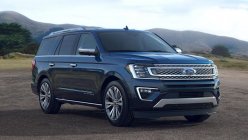The Toyota Hilux already spans more than five decades, securing a reputation for toughness and reliability along the way. It has journeyed to both the North and South Poles, participated in motorsports via the gruelling Dakar Rally, and even had a war named after it (the Chadian-Libyan war of 1987 or the “Toyota War,” so-called because the Hilux was used as a troop transport by both sides).

The Hilux remains a benchmark for toughness and reliability
The Hilux actually started out in the 1960s as a small truck called the Briska, made by Hino. Toyota had some inputs on how the Briska can be improved, and in 1967 the two companies agreed to manufacture the vehicle under the Toyota marque.
Here’s how the Toyota Hilux embarked on its journey towards being one of Toyota’s most iconic vehicles.
First Generation (1968-1972)
Conceived as a light-duty commercial vehicle, the Hilux was named using a portmanteau of “high” and “luxury”. The first Hilux had a chassis code designation of N10, and came in two cargo bed sizes: standard (1,850 mm) and extended wheelbase (2,250 mm). There were also aluminum van and refrigerated versions.

The first Hilux was actually a small Hino truck called the Briska
The first Hilux was mounted on a separate frame construction riding on double wishbone/coil springs in front and leaf spring suspension at the rear. Power initially came from a 1.5L 4-cylinder OHV engine generating 69 hp, coursing to the rear wheels through a column-mounted 4-speed manual transmission.
The engine would eventually be replaced by a 1.6L model that made 83 hp. Three passengers sat abreast on a bench-type seat. The standard wheelbase variant was sold in the U.S. market under the name Toyota Truck, equipped with bigger 1.9L and 2.0L engines.
Second Generation (1972-1978)
The second-generation Hilux carried the N20 chassis code, and came in both 1.5L and 1.9L engines. The 4-speed manual had a floor-mounted option, which meant that the bench could be exchanged with bucket seats for two occupants.
The extended wheelbase version was finally made available in the U.S., with a 2.5L engine and 5-speed manual transmission.
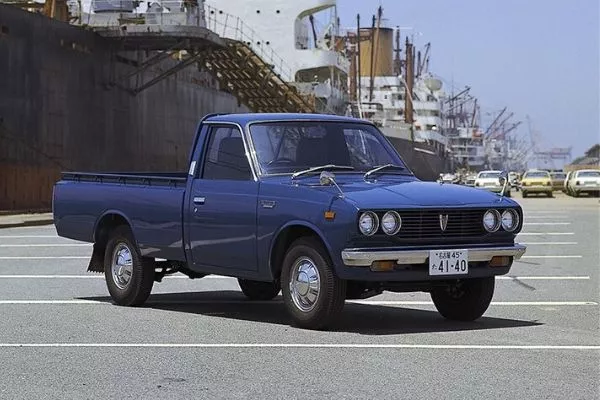
An automatic transmission first became available on the second-generation Hilux
This generation marked two milestones: it was the first Hilux to be introduced in the U.K., and the first to offer a 3-speed automatic transmission, partnered with a 2.0L R-series engine.
The engine would eventually be replaced in 1975 with a 1.6L powerplant to comply with emissions standards.
>>> Related: What comes with the Toyota Hilux 2020 Philippines? Take a glimpse from the updated Aus-spec version
Third Generation (1978-1983)
Chassis code N30 was used on the third-generation Hilux, which saw a suspension upgrade from coil springs to torsion bar. Front disc brakes became standard kit for higher-spec variants, and customers can order a special tailgate embossed with the Toyota name.

The third generation was the first to have a diesel engine and four-wheel-drive
The third generation was notable for being the first to use a four-wheel drivetrain, with a driveline and transfer case adapted from the Land Cruiser 40 Series, powered by a 2.0L gasoline engine. It’s also the first Hilux to offer a diesel engine, in the form of a 2.2L oil burner.
Fourth Generation (1983-1988)
The fourth-generation Hilux featured a refreshed design by way of blistered arches, and a revamped interior. Single and double cab versions were released, along with an elevated-bed variant equipped with all three sides hinged at the bottom.
The engine choices were expanded; 2WD versions came with four engines (1.6L and 1.8L gasoline, 2.2L and 2.2L diesel), while 4WD variants offered a 2.0L gasoline and 2.4L diesel.

The fourth generation served as the basis for the Toyota 4Runner SUV
By this time, recreational vehicles such as the Ford Bronco and Nissan Pathfinder were gaining prominence. In response, Toyota modified the Hilux by installing a one-piece fiberglass canopy and rear bench seats, as well as installing bigger 2.4L turbo and 3.0L V6 gasoline engines. The result was the Hilux Surf, sold in other markets as the Toyota 4Runner.
>>> Related: 2020 Ford Ranger vs Toyota Hilux Comparison: Spec Sheet Battle
Fifth Generation (1988-1997)
With the fifth generation, Toyota sought to differentiate the Hilux 4WD from the 2WD variants with the use of overfenders. The former came with 2.0L gasoline and 2.8L diesel powerplants, while 1.8L gasoline and 2.4L diesel engines powered the latter.
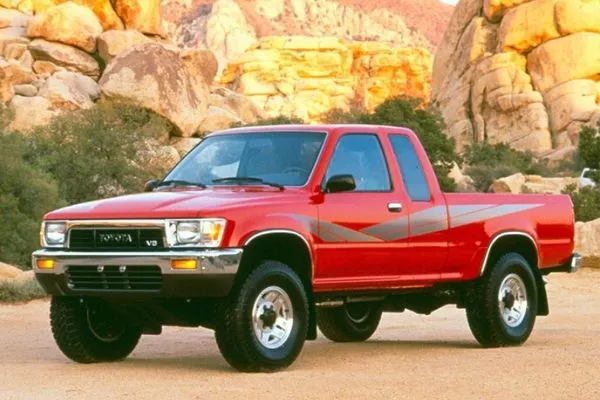
This generation was the last Hilux line to be sold in the United States
Double cab 4WD models also received a front independent double-wishbone suspension with torsion bar. Meanwhile, the interior was revised again to give a more sedan-like look and feel.
In August 1994, the 2WD range began to adopt the 4WD engine lineup, and a 2.4L turbodiesel option was added one year later. In US markets, the Hilux was eventually replaced with the larger Tacoma for the 1995 model year.
Sixth Generation (1997-2004)
After spinning off the Hilux Surf/4Runner into a separate model range, Toyota focused on the Hilux’s dual role as both workhorse and personal-use sports pickup.
Variants used for business had more basic features, while the lifestyle trims had their cabin’s height and length extended, with improved sound insulation. Front independent suspension became standard across the range.

The sixth-generation Hilux assumed dual roles as a business and leisure model
It offered the Hilux as a single or double cab body, in either 2WD or 4WD drivetrains with four engine choices: 2.0L and 2.7L for gasoline, 3.0L naturally-aspirated and 2.4L turbo for diesel.
>>> Related:
- Why the Toyota Hilux is extremely popular among Filipino car buyers
- 2021 Toyota Hilux facelift rendering shows better view of new face
Seventh Generation (2004-2015)
This release saw the Hilux using the IMV (Innovative International Multi-purpose Vehicle) platform, which it shared with the Fortuner midsize SUV and Innova MPV, resulting in increased interior space and upgraded load capacity.
The 2.5L D-4D engine would be accompanied by a 3.0L 16-valve equivalent, making the Hilux compliant with Euro 4 emissions standards.

Toyota brought Hilux production out of Japan for the first time with the seventh generation
The seventh generation also marks the first time that Hilux production was brought outside of Japan, with most units assembled in Thailand, South Africa, and Argentina.
Hilux units for the 2012 model year underwent exterior and interior restyling, with mid-range and top-spec variants getting the latest Toyota Touch Multimedia system.
Eighth Generation (2015-Present)
Toyota used feedback from its global customer base to design and engineer the Hilux using the “redefining toughness” development concept.
This meant that the new model now featured increased durability, enhanced comfort and communications, as well as improved cruising range brought about by better fuel efficiency.
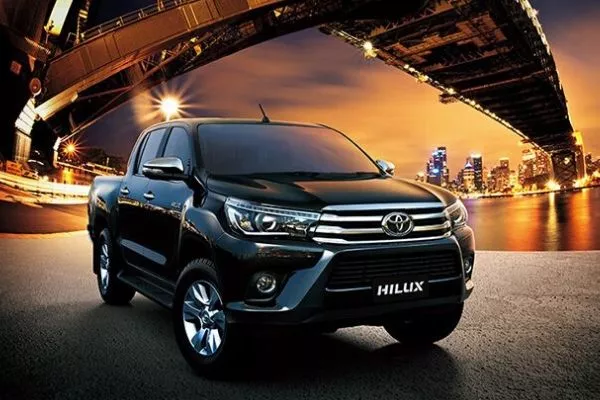
Toyota gathered feedback from customers worldwide in creating the current Hilux
>>> Related: Latest updates in Toyota Hilux Philippines price
The present Hilux uses a stronger ladder frame chassis with a reinforced deck. Improved 4WD capability also translates into uprated towing capacity.
By 2015, 16 million Hilux units have been sold worldwide, with Europe making up almost 25% of this figure. In the Philippines, the Hilux has sold nearly 21,000 units in 2019, the second best-selling Toyota model next to the Vios.
For the 2020 model year, the Hilux underwent a facelift while retaining the current IMV platform. The new Hilux Revo sports a bolder appearance, with a fascia comprising a more prominent grille, new Bi-Beam LED headlamps, and a more aggressive bumper. Redesigned double C-shaped taillamps make the truck even more visible during stops.

The new Hilux for the 2020 model year looks more aggressive and packs more power
Inside, a black color motif lends a premium appearance to the cabin, while a new 8-inch touchscreen now includes Apple CarPlay connectivity. Variable Flow Control power steering regulates steering stiffness based on vehicle speed, to reduce driver stress.
The standard 2.8L diesel engine has been tweaked to produce an incredible 500 Nm of torque, while adjustments to the suspension promise a more comfortable ride while retaining the Hilux’s class-leading payload capacity. And for the first time, the Hilux Revo is equipped with the Toyota Safety Sense suite of driver-assistive features such as Pre-Collision Alert, Dynamic Radar Cruise Control, and Lane Departure Alert.
Do you own a Hilux, whether new or old? What’s your Hilux story? Keep reading Philkotse.com to learn more about your favorite rides.
Know more about Toyota Hilux 2025

The Toyota Hilux 2025 is a midsize pickup offered in the local market as both fleet and regular units. Toyota Hilux Prices Philippines range from PHP 891,000 to PHP 2,198,000 with 13 variants, spanning from the basic cab & chassis 4x2 model to the range-topping GR Sport 4x4. It is also available in two turbodiesel engine options and four gearbox choices, accompanied by eight exterior colors. Dimensions start at 5,285mm in height, 1,800mm in width, and 1,700mm in height, with a wheelbase of 3,085mm. Among the rivals to the Toyota Hilux in the market are the Mitsubishi Strada, Nissan Navara, Ford Ranger, and the Isuzu D-Max.
This popular pickup continues to evolve and slowly move upmarket after gaining luxuries. The most significant revolutionary jump of the Hilux happened in 2004 when the seventh generation of the model was introduced. It was the first 21st-century iteration of Toyota's pickup. It is also the first generation to ride on Toyota’s new Innovative Multi-purpose Vehicle architecture. It provided improved safety, better ride comfort, modern D-4D diesel engines, more interior space, and a more modern aerodynamic body.
The current 8th generation offers a more refined and stylish design than its predecessor, but the tradition of being a tough pickup continues. It received a much-awaited refresh in 2020.
>>> New and used Toyota Hilux 2025 for sale in the Philippines
Toyota Hilux Launch
Toyota Motor Philippines (TMP) debuted the refreshed Toyota Hilux in 2020, featuring a meaner and more aggressive pickup truck design from the front to the back. The biggest update the Japanese carmaker added to the latest model is the minor power bump for the 2.8-liter engine option, which now makes it one of the most powerful in terms of performance numbers.
To cater to different car consumers who are in the automotive market for a reliable workhorse, TMP is offering its pickup truck with a wide array of variants, namely the Cab & Chassis, Cargo, J, FX, E, J, G, and the top-of-the-line Conquest. Only the top-ranging variant gets to benefit from the updated engine that now joins the superb 500 Club alongside the Ford Ranger
For 2025, the GR Sport received a massive update and it is now more powerful and more off-road capable than its predecessor. The brand also added a new E AT trim to its variant lineup.
Toyota Hilux Exterior
The current generation Toyota Hilux features a bolder and more rugged exterior styling. When Toyota's business unit in the Philippines introduced the Conquest variant of the Hilux, it received some much-needed flare. The top variants can turn heads because of their several external enhancements. The Conquest variant of the Hilux features a more aggressive exterior design while the standard variant leans on the safer side.
Upfront, it can come with either a set of projector or reflector halogen headlights, depending on the chosen variant. The higher trim levels feature an LED lighting set, as well as benefit from an array of DRLs. The E and G variants ride on 17-inch wheels, while the Conquest uses 18-inch gloss black alloy wheels. The new GR Sport meanwhile, also uses a 17-inch though these are off-road ready, Dakar-inspired wheels.

The current generation Toyota Hilux features a bolder exterior
Other exclusive features made available on the Toyota Hilux Conquest variants only include a tailgate assist, a bedliner, a sports bar, a roof ornament, and side decals to provide a sturdier road presence on the go.
The GR Sport meanwhile, gets a wider track width, a set of beefier fender flares, an aero sports bar, under chassis protection, etc.
Toyota Hilux Interior
The Toyota Hilux currently on sale mostly carries over the interior from the 2020 update. Inside the pickup, there is the right amount of dimensionality that is also found in other Toyota vehicles offered in the Philippines that sit on the same platform. However, there are subtler styling elements that distinctly mark it as Hilux.
Higher trim levels feature seats with leather wrappings while lower trims have fabric seat coverings. Top variants are also equipped with automatic climate control and steering wheel audio control that depends on the head unit. The twin-dial setup gauge cluster comes with a multi-function display in the middle.
Technology & Safety Features
For on-board entertainment, Toyota gave the G a new eight-inch touchscreen. The Conquest likewise uses an eight-inch display, while the updated GR-S comes with a nine-inch headunit. The E meanwhile, retains its 6.75-inch display. Standard on the Conquest and GR-Sport is wireless Android Auto, wireless Apple CarPlay, Bluetooth, and USB connectivity. The displays on the G though, get the wired version of Apple CarPlay and Android Auto.
The top-range variants come with a push-start system and keyless entry. Hill-start assist is also available in this pickup. It adds to the livability and drivability of the Toyota Hilux. Depending on the trim, the Hilux also gets radar cruise control.

Safety is not an issue for the Toyota Hilux
This popular pickup from Toyota is a safe vehicle. The basic variant features passenger’s and driver’s airbags as standard. Higher variants have two front, side, and curtain airbags. Other safety features include ABS with EBD, brake assist, stability control, and speed-sensing door locks.
The GR-S and the Conquest get the Toyota Safety Sense driver-assistive kit, which includes a pre-collision system, lane departure alert, and more. The higher-spec trims also have blind-spot monitoring, rear cross-traffic alert, and a panoramic view parking camera.
Platform & Chassis
The Toyota Hilux is a midsize four-door pickup truck. It shares the same Toyota IMV platform as Innova and Fortuner. This pickup truck features a double-wishbone front suspension, and the rear setup is a rigid axle with leaf springs to further bolster its reputation as a reliable workhorse in the Philippines.
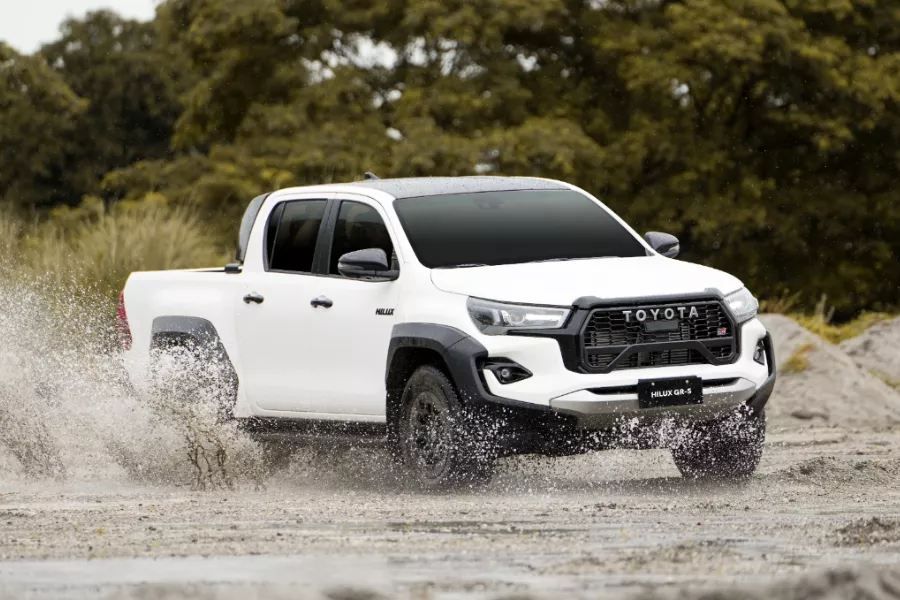
Toyota's pickup truck has a commanding presence on the road
On the top-spec GR Sport, the Hilux's suspension system is updated with monotube shock absorbers. It is also the only trim that gets disc brakes for all four wheels.
Engine & Drivetrain
Under the hood, TMP offers two engine options for its entry to the Philippine pickup truck segment. The first engine option is a 2.4-liter 2GD-FTV diesel engine which is used on the E, G, and Conquest 4x2 variants. It can generate 148 hp at 3,400 rpm and 400 Nm of torque at 1,600 to 2,000 rpm.
The second engine option for the model is a larger 2.8-liter 1GD-FTV turbo-diesel engine which is capable of generating 201 hp at 3,400 rpm and 420 Nm of torque at 1,400 to 3,400 rpm (500 Nm of torque for the top-of-the-line Conquest 4X4 A/T variant). Both the said engines can be paired to either a 6-speed manual or 6-speed automatic transmission, depending on the chosen variant.
The updated 2025 GR-Sport meanwhile, is propelled by a 2.8-liter turbodiesel that can generate up to 220 horsepower and 550 Nm of torque. Like the other automatic versions, it also uses a six-speed gearbox, but this has been tuned for better performance.
>>> Related posts:
- 2020 Ford Ranger vs Toyota Hilux Comparison: Spec Sheet Battle
- What comes with the Toyota Hilux 2020 Philippines? Take a glimpse at the updated Aus-spec version
Available colors for the Toyota Hilux Philippines are Super White, Silver Metallic, Gray Metallic, Attitude Black Mica, Crimson Spark Red Metallic, Nebula Blue Metallic, Orange Metallic, and Emotional Red.
Much like most of its rivals, the Toyota Hilux 2025 comes with a rear-locking differential for added traction and control in slippery driving conditions, especially when off-road. It also retains its 1,115-kilogram payload capacity, one of the highest in its segment, for superb carrying capability. Toyota has equipped the Hilux with a variable-flow control power steering pump to relieve driver stress during strenuous drives.
Toyota Hilux Pros & Cons
Pros
- Rugged appearance
- High payload capacity
- Improved steering
- Powerful engine choices
Cons
- Harsh ride
- No power tailgate function
- Top-spec variant is expensive compared to its rivals
Toyota Hilux 2025 Price List
| Variants | Price |
|---|---|
| Toyota Hilux 2.4 Cab & Chassis 4x2 MT | ₱891,000 |
| Toyota Hilux 2.4 J DSL 4x2 MT | ₱1,001,000 |
| Toyota Hilux 2.4 Cargo 4x2 MT | ₱1,007,000 |
| Toyota Hilux 2.4 FX 4x2 MT (w/ rear A/C) | ₱1,130,000 |
| Toyota Hilux 2.4 J DSL 4x4 MT | ₱1,201,000 |
| Toyota Hilux 2.4 E DSL 4x2 MT | ₱1,318,000 |
| Toyota Hilux 2.4 G DSL 4x2 MT | ₱1,396,000 |
| Toyota Hilux 2.4 E DSL 4x2 AT | ₱1,398,000 |
| Toyota Hilux 2.4 G DSL 4x2 AT | ₱1,472,000 |
| Toyota Hilux Conquest 2.4 DSL 4x2 AT | ₱1,681,000 |
| Toyota Hilux Conquest 2.4 DSL 4x2 AT (Emotional Red) | ₱1,701,000 |
| Toyota Hilux Conquest 2.8 DSL 4x4 MT | ₱2,009,000 |
| Toyota Hilux Conquest 2.8 DSL 4x4 MT (Emotional Red) | ₱2,029,000 |
| Toyota Hilux Conquest 2.8 DSL 4x4 AT | ₱2,084,000 |
| Toyota Hilux Conquest 2.8 DSL 4x4 AT (Emotional Red) | ₱2,104,000 |
| Toyota Hilux 2.8 GR Sport AT | ₱2,164,000 |
| Toyota Hilux 2.8 GR-S 4x4 AT | ₱2,178,000 |
| Toyota Hilux 2.8 GR Sport AT (Emotional Red) | ₱2,184,000 |
| Toyota Hilux 2.8 GR-S 4x4 AT (Emotional Red) | ₱2,384,000 |
Toyota Hilux FAQs
1. How much is the Toyota Hilux 2025 Philippines?
Toyota Hilux 2025 price Philippines ranges from 885,000 PHP for the entry-level 2.4 Cab & Chassis 4x2 MT to 2,192,000 PHP for the top-of-the-line Toyota Hilux GR Sport 2.8 4x4 AT (Emotional Red color).
2. What are the Dimensions of Hilux 2025?
Dimensions for the Toyota Hilux 2025 include 5,285mm in length, 1,800mm in width, and 1,700mm in height, with a wheelbase of 3,085mm.
3. What are the colors available in Hilux Philippines?
Toyota Hilux 2025 colors are available in 5 colors in the following shades: White, Super White, Sliver Metallic, Gray Metallic, Crimson Red, Attitude Black Mica, Nebula Blue Metallic, Orange Metallic, and Emotional Red.
4. What is the Engine Capacity of Hilux Conquest 2.4 4x2 MT?
Toyota Hilux Conquest 2.4 4x2 MT is offered with a 2.4-liter 2GD-FTV diesel engine which can generate 148 hp at 3,400 rpm and 400 Nm of torque at 1,600 to 2,000 rpm.
5. Is the Toyota Hilux available in Automatic Transmission?
Yes, it is. All Hilux trims available in the Philippines are automatic transmissions.
₱ 879,000 - ₱ 2,166,000
ExploreRecent posts
- Toyota Hilux vs Nissan Navara Philippines: Truck battle! Dec 28, 2022
- New 2021 Toyota Hilux renderings preview facelifted truck in the metal Mar 30, 2021
- 2021 Toyota Hilux facelift leaked with Tacoma-inspired design Jun 03, 2021
- Rejoice! Toyota might be developing a GR Hilux in the near future Mar 23, 2021
- Toyota Hilux vs Strada 2020 Comparo: Keep on Trucking Nov 15, 2022


